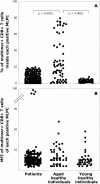Cytolytic T-cell response against Epstein-Barr virus in lung cancer patients and healthy subjects
- PMID: 20525347
- PMCID: PMC2907867
- DOI: 10.1186/1756-9966-29-64
Cytolytic T-cell response against Epstein-Barr virus in lung cancer patients and healthy subjects
Abstract
Background: This study aimed to examine whether EBV seropositive patients with lung cancer have an altered virus-specific CTL response, as compared to age-matched healthy controls and whether any variation in this response could be attributed to senescence.
Methods: Peripheral blood mononuclear cells from lung cancer patients, age-matched and younger healthy individuals were used to measure EBV-specific CTLs after in vitro amplification with the GLCTLVAML and RYSIFFDYM peptides followed by HLA-multimer staining.
Results: Lung cancer patients and aged-matched controls had significantly lesser EBV-specific CTL than younger healthy individuals. Multimer positive populations from either group did not differ with respect to the percentage of multimer positive CTLs and the intensity of multimer binding.
Conclusions: This study provides evidence that patients with lung cancer exhibit an EBV-specific CTL response equivalent to that of age-matched healthy counterparts. These data warrant the examination of whether young individuals have a more robust anti-tumor response, as is the case with the anti-EBV response.
Figures



Similar articles
-
Dynamic CD8 T-cell responses to tumor-associated Epstein-Barr virus antigens in patients with Epstein-Barr virus-negative Hodgkin's disease.Oncol Res. 2009;18(5-6):287-92. doi: 10.3727/096504009x12596189659169. Oncol Res. 2009. PMID: 20225766 Free PMC article.
-
Immune reconstitution of HLA-A*0201/BMLF1- and HLA-A*1101/LMP2-specific Epstein Barr virus cytotoxic T lymphocytes within 90 days after haploidentical hematopoietic stem cell transplantation.Virol J. 2019 Feb 8;16(1):19. doi: 10.1186/s12985-019-1123-y. Virol J. 2019. PMID: 30736814 Free PMC article.
-
Assessment and characterization of the cytolytic T lymphocyte response against Epstein-Barr virus in patients with non-Hodgkin's lymphoma after autologous peripheral blood stem cell transplantation.Bone Marrow Transplant. 1998 May;21(9):909-16. doi: 10.1038/sj.bmt.1701197. Bone Marrow Transplant. 1998. PMID: 9613783
-
Treatment options for post-transplant lymphoproliferative disorder and other Epstein-Barr virus-associated malignancies.Tissue Antigens. 2004 Apr;63(4):285-92. doi: 10.1111/j.0001-2815.2004.00227.x. Tissue Antigens. 2004. PMID: 15009802 Review.
-
EBV specific CTL: a model for immune therapy.Vox Sang. 1998;74 Suppl 2:497-8. doi: 10.1111/j.1423-0410.1998.tb05463.x. Vox Sang. 1998. PMID: 9704488 Review.
References
-
- Karanikas V, Tsochas S, Boukas K, Kerenidi T, Nakou M, Dahabreh J, Poularakis T, Gourgoulianis KI, Germenis AE. Co-expression patterns of tumor-associated antigen genes by non-small cell lung carcinomas: Implications for immunotherapy. Cancer Biol Ther. 2008;7:345–352. doi: 10.4161/cbt.7.3.5424. - DOI - PubMed
Publication types
MeSH terms
LinkOut - more resources
Full Text Sources
Medical
Molecular Biology Databases
Research Materials

